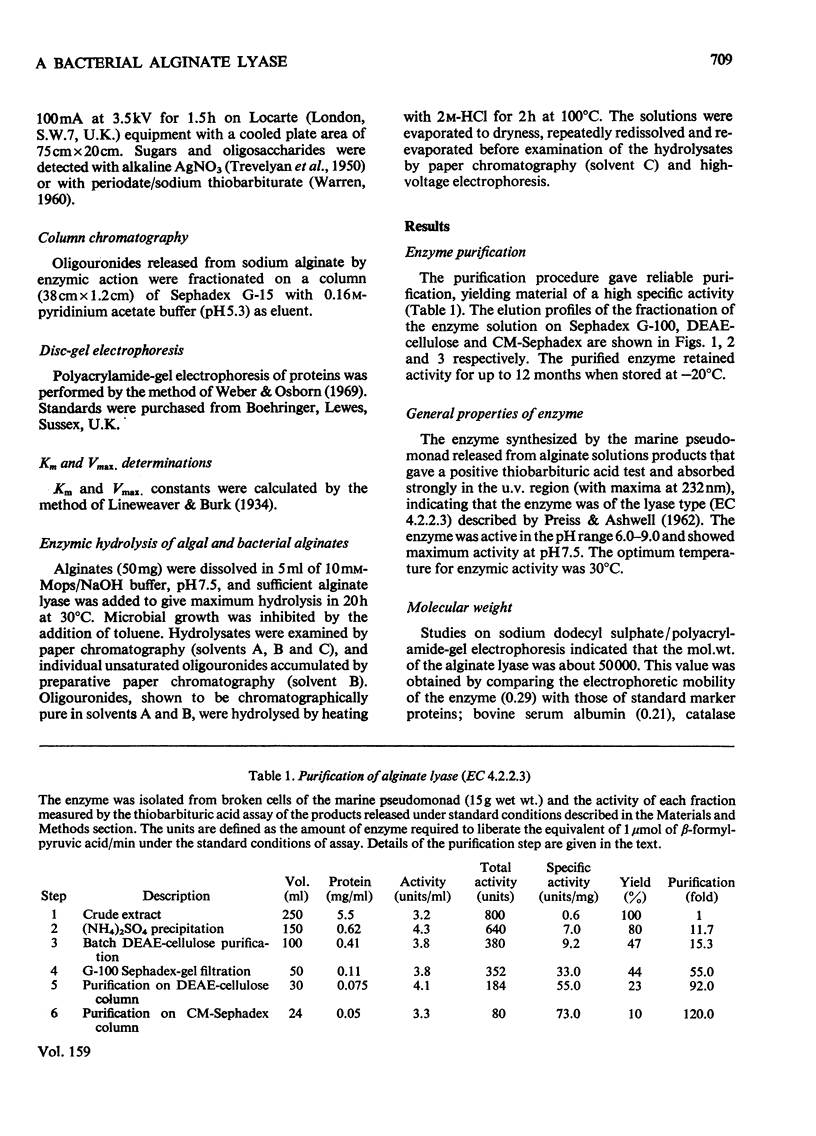Abstract
An unidentified pseudomonad isolated by enrichment procedures from decomposing seaweed was grown in defined medium containing sodium alginate as the sole carbon source. The alginate lyase recovered from disrupted bacterial cells was purified by a procedure of (NH4)2SO4 precipitation, gel filtration and ion-exchange chromatography. From sodium dodecyl sulphate/polyacrylamide-gel-electrophoresis experiments a mol.wt. of about 50 000 was determined. The enzyme was active against both algal and bacterial alginate preparations. Kinetic studies together with analysis of the unsaturated oligouronide products of alginate lyase action indicated the enzyme was specific for guluronic acid-containing regions of the macromolecular substrate. The specificity of the enzyme can be used to give information about the primary composition of alginate samples.
Full text
PDF






Selected References
These references are in PubMed. This may not be the complete list of references from this article.
- Atkins E. D., Mackie W., Smolko E. E. Crystalline structures of alginic acids. Nature. 1970 Feb 14;225(5233):626–628. doi: 10.1038/225626a0. [DOI] [PubMed] [Google Scholar]
- Bucke C. Polyacrylamide gel electrophoresis of alginic acid. J Chromatogr. 1974 Feb 13;89(1):99–102. doi: 10.1016/s0021-9673(01)84167-4. [DOI] [PubMed] [Google Scholar]
- COWAN S. T., STEEL K. J. Diagnostic tables for the common medical bacteria. J Hyg (Lond) 1961 Sep;59:357–372. doi: 10.1017/s0022172400039024. [DOI] [PMC free article] [PubMed] [Google Scholar]
- Kashiwabara Y., Suzuki H., Nisizawa K. Alginate lyases of pseudomonads. J Biochem. 1969 Oct;66(4):503–512. doi: 10.1093/oxfordjournals.jbchem.a129175. [DOI] [PubMed] [Google Scholar]
- LINKER A., JONES R. S. A POLYSACCHARIDE RESEMBLING ALGINIC ACID FROM A PSEUDOMONAS MICRO-ORGANISM. Nature. 1964 Oct 10;204:187–188. doi: 10.1038/204187a0. [DOI] [PubMed] [Google Scholar]
- LOWRY O. H., ROSEBROUGH N. J., FARR A. L., RANDALL R. J. Protein measurement with the Folin phenol reagent. J Biol Chem. 1951 Nov;193(1):265–275. [PubMed] [Google Scholar]
- Nakada H. I., Sweeny P. C. Alginic acid degradation by eliminases from abalone hepatopancreas. J Biol Chem. 1967 Mar 10;242(5):845–851. [PubMed] [Google Scholar]
- PREISS J., ASHWELL G. Alginic acid metabolism in bacteria. I. Enzymatic formation of unsaturated oligosac-charides and 4-deoxy-L-erythro-5-hexoseulose uronic acid. J Biol Chem. 1962 Feb;237:309–316. [PubMed] [Google Scholar]
- Penman A., Sanderson G. R. A method for the determination of uronic acid sequence in alginates. Carbohydr Res. 1972 Dec;25(2):273–282. doi: 10.1016/s0008-6215(00)81637-7. [DOI] [PubMed] [Google Scholar]
- WARREN L. Thiobarbituric acid spray reaction for deoxy sugars and sialic acids. Nature. 1960 Apr 16;186:237–237. doi: 10.1038/186237a0. [DOI] [PubMed] [Google Scholar]
- WEISSBACH A., HURWITZ J. The formation of 2-keto-3-deoxyheptonic acid in extracts of Escherichia coli B. I. Identification. J Biol Chem. 1959 Apr;234(4):705–709. [PubMed] [Google Scholar]
- Weber K., Osborn M. The reliability of molecular weight determinations by dodecyl sulfate-polyacrylamide gel electrophoresis. J Biol Chem. 1969 Aug 25;244(16):4406–4412. [PubMed] [Google Scholar]


